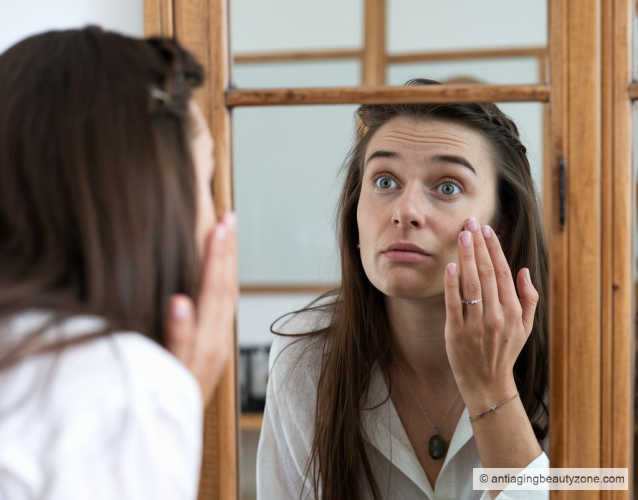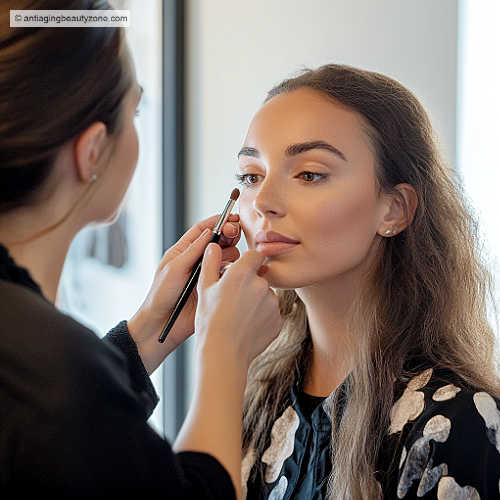Why is it important to find your eye shape?
Understanding the contours of your eyes can be a real game-changer for enhancing your natural beauty. Ever wonder why certain makeup looks dazzle while others just miss the mark? The secret might lie in recognizing the shape of your eyes.

Whether they’re almond, round, monolid, or another shape, knowing this helps you pick the techniques that suit you best. By customizing your makeup routine to your eye structure, you can accentuate your best features and achieve a more polished look.
Won’t it be nice to feel confident with makeup that’s perfect for your eyes? With a little know-how, you can make every makeup session a success.
Ready to see how knowing your eye shape can upgrade your beauty routine? Let’s get started and find your perfect look!
look straight ahead in a mirror

A simple way to get a clearer picture of your eye shape, is to look straight on in a mirror. Then follow these steps:
Determine the Visibility of Your Crease:
- Hooded Eyes: If the skin from your brow bone droops down over the crease, making it less visible or completely hidden when your eyes are open, you likely have hooded eyes.
- Monolid Eyes: If you don’t have a visible crease and your eyelid appears flat, you probably have monolid eyes.
- Prominent Crease: If your crease is easily visible, you might have almond, round, or another open eye shape.
Check the Position of Your Outer Corners:
- Upturned Eyes: If the outer corners of your eyes are higher than the inner corners, your eyes are upturned.
- Downturned Eyes: If the outer corners dip lower than the inner corners, your eyes are downturned.
- Straight Eyes: If the outer corners are level with the inner corners, your eyes are more straight or neutral.
Assess the Overall Shape:
- Almond Eyes: Oval shape with slightly pointed corners and a visible crease; width is greater than height, resembling an almond.
- Round Eyes: Wide and large, with a visible crease and more whites showing around the iris.
- Close-Set or Wide-Set Eyes: If the distance between your eyes is less than or greater than one eye width, your eyes are close-set or wide-set, respectively.
Observe the Depth of Your Eyes:
- Deep-Set Eyes: Eyes are set back into the sockets, making the brow bone appear more prominent.
- Protruding Eyes: Eyes extend outward more than usual, with the eyeball appearing more prominent.
This method helps you understand the specifics of your eye shape and choose the most flattering makeup techniques for your unique features.
outline your eye contour: mirror mapping

I found the mirror test the best and most accurate way to determine the shape. I used a soft black (cheap) eyeliner pencil that I purchased at the Dollar Store. 😉
Position Yourself and Prepare:
In a well-lit room stand or sit in front of a mirror at eye level. Ensure the mirror is clean and free from smudges.
Draw the Reference Line:
Using a pencil or non-permanent marker, draw a horizontal line across the mirror at the level of your pupils while looking straight ahead.
This line should be parallel to your eyelid when your eyes are open. It will help you determine the general alignment and symmetry of your eyes.
Trace Your Eye Shape:
With the same pencil or marker, gently trace the outline of your eye shape on the mirror while looking directly at your reflection. Focus on tracing both the top and bottom contours of your eye.
- For Round Eyes: The tracing will show a rounded shape.
- For Almond Eyes: The tracing will reveal a more elongated, almond shape.
- For Other Shapes: The tracing will reflect the specific contour of your eye shape, whether it’s monolid, hooded, etc.
Compare the Line and Shape:
Observe how your eye shape aligns with the horizontal reference line. This will help you see if your eyes are upturned, downturned, or level, and how this affects your overall eye shape.
By following these steps, you can better understand your eye’s natural contours and choose makeup techniques that enhance your specific eye shape.
use pictures to find your eye shape
Taking clear photos of your eyes helps you see their shape better than a mirror. Photos let you view your eyes from different angles and in good lighting, so you can notice details you might miss otherwise. This helps you spot any differences or features that can affect your makeup too.
How to Take the Best Photo:
- Use Good Lighting: Natural light or a bright lamp works best to avoid shadows.
- Capture Multiple Angles: Take pictures from straight-on and slightly to the side to see different views.
- Ask for Help: Have someone else take the photos to keep the camera steady and properly positioned.
- Keep the Camera Steady: If you’re taking the photo yourself, use a tripod or keep your hands still to avoid blurriness.
- Close-Up Shots: Zoom in to get clear, detailed images of your eyes. This makes it easier to see details like the crease shape and any differences.
Using these tips will help you get a clear view of your eye shape, making it easier to choose the right makeup techniques.
measure shape and symmetry
Measuring your eyes can be a precise way to understand their shape and symmetry. It might not be the easiest method, but if you’re good with numbers, it can give you a clear idea.
By measuring things like the distance between the corners of your eyes or the height of your eyelid creases, you can see how your eyes are shaped and if they are even. This can help you adjust your makeup for a more balanced look.
To get started, follow these easy steps:
Get Your Tools:
- Use a ruler. A soft measuring tape with small markings will work much better than a hard ruler.
Take Measurements:
- Eye Width: Measure from the outer corner of one eye to the outer corner of the other.
- Crease Height: Measure from the top of your eyelid to the crease, if you have one.
- Pupil to Outer Corner: Measure from the center of your pupil to the outer corner of your eye.
Write Down Your Results:
- Note down your measurements so you can see any differences between your eyes.
Compare and Adjust:
- Look at the measurements for both eyes. If they’re not the same, use this info to adjust your makeup and make both eyes look more balanced.
Using these measurements can help you apply makeup (see tips below) in a way that highlights your eye shape and evens things out.
get professional advice

Need a little help?
A pro makeup artist can give you personalized tips that really work for your unique eye shape. They’ll show you the best techniques to bring out your natural beauty and even solve any specific makeup challenges you’ve got. Plus, you’ll walk away with some game-changing tricks you can use every day.
enhance your makeup with eye shape knowledge
Now that you’ve mastered identifying your eye shape, you’re ready to use this information to elevate your makeup game.
Understanding your eye shape helps you choose the best eyeliner makeup techniques to highlight your natural beauty. Check out our Eyeliner by Eye Shape page for tailored tips and tricks that suit your unique eye shape.
But what if your eyes aren’t perfectly symmetrical? Don’t worry—makeup can help balance things out and make your eyes look their best.
Here are some simple ways to correct asymmetry and enhance symmetry:
Simple tips to correct asymmetry
By customizing your makeup application to your specific eye shape, you can make your eyes appear larger or more defined. And balance asymmetry between your eyes by highlighting or minimizing certain features (like lifting drooping outer corners).
Eyeliner: Apply a less eyeliner to a smaller eye or adjust the line to even things out. This helps make both eyes look more similar. Heavy eyeliner can make an eye look smaller.
Eyeshadow: Blend more eyeshadow on the smaller eye to make it look more balanced with the larger one.
Highlighting: Use a highlighter on areas you want to stand out. This can create the illusion of more even eyes.
Contouring: Apply contour to areas that need balancing. It can help make your eyes look more symmetrical.
before you go…
If you enjoyed this content, show some love by tapping the 💙 in the bottom right corner (you’ll find it on almost every page). It lets me know you found it helpful and fun. Thanks a bunch!

